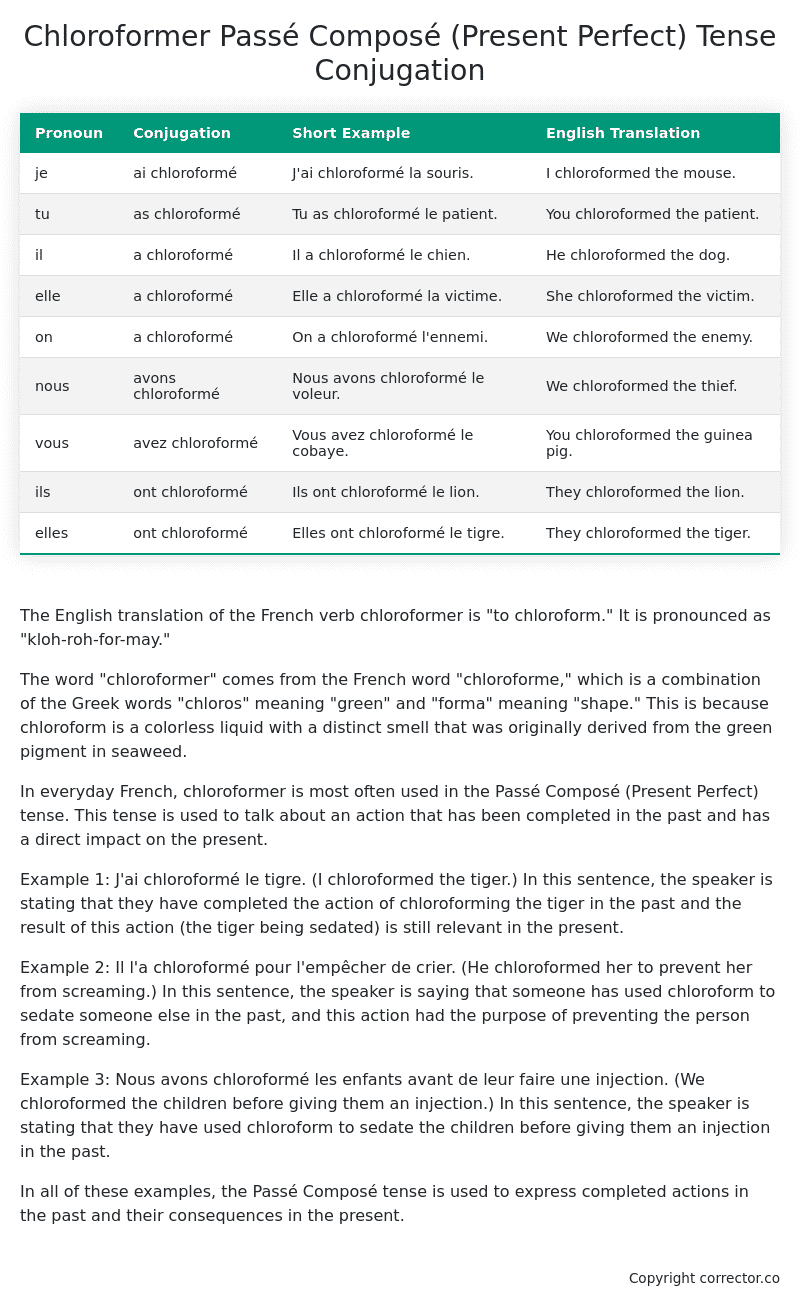Passé Composé (Present Perfect) Tense Conjugation of the French Verb chloroformer
Introduction to the verb chloroformer
The English translation of the French verb chloroformer is “to chloroform.” It is pronounced as “kloh-roh-for-may.”
The word “chloroformer” comes from the French word “chloroforme,” which is a combination of the Greek words “chloros” meaning “green” and “forma” meaning “shape.” This is because chloroform is a colorless liquid with a distinct smell that was originally derived from the green pigment in seaweed.
In everyday French, chloroformer is most often used in the Passé Composé (Present Perfect) tense. This tense is used to talk about an action that has been completed in the past and has a direct impact on the present.
Example 1: J’ai chloroformé le tigre. (I chloroformed the tiger.) In this sentence, the speaker is stating that they have completed the action of chloroforming the tiger in the past and the result of this action (the tiger being sedated) is still relevant in the present.
Example 2: Il l’a chloroformé pour l’empêcher de crier. (He chloroformed her to prevent her from screaming.) In this sentence, the speaker is saying that someone has used chloroform to sedate someone else in the past, and this action had the purpose of preventing the person from screaming.
Example 3: Nous avons chloroformé les enfants avant de leur faire une injection. (We chloroformed the children before giving them an injection.) In this sentence, the speaker is stating that they have used chloroform to sedate the children before giving them an injection in the past.
In all of these examples, the Passé Composé tense is used to express completed actions in the past and their consequences in the present.
Table of the Passé Composé (Present Perfect) Tense Conjugation of chloroformer
| Pronoun | Conjugation | Short Example | English Translation |
|---|---|---|---|
| je | ai chloroformé | J’ai chloroformé la souris. | I chloroformed the mouse. |
| tu | as chloroformé | Tu as chloroformé le patient. | You chloroformed the patient. |
| il | a chloroformé | Il a chloroformé le chien. | He chloroformed the dog. |
| elle | a chloroformé | Elle a chloroformé la victime. | She chloroformed the victim. |
| on | a chloroformé | On a chloroformé l’ennemi. | We chloroformed the enemy. |
| nous | avons chloroformé | Nous avons chloroformé le voleur. | We chloroformed the thief. |
| vous | avez chloroformé | Vous avez chloroformé le cobaye. | You chloroformed the guinea pig. |
| ils | ont chloroformé | Ils ont chloroformé le lion. | They chloroformed the lion. |
| elles | ont chloroformé | Elles ont chloroformé le tigre. | They chloroformed the tiger. |
Other Conjugations for Chloroformer.
Le Present (Present Tense) Conjugation of the French Verb chloroformer
Imparfait (Imperfect) Tense Conjugation of the French Verb chloroformer
Passé Simple (Simple Past) Tense Conjugation of the French Verb chloroformer
Passé Composé (Present Perfect) Tense Conjugation of the French Verb chloroformer (this article)
Futur Simple (Simple Future) Tense Conjugation of the French Verb chloroformer
Futur Proche (Near Future) Tense Conjugation of the French Verb chloroformer
Plus-que-parfait (Pluperfect) Tense Conjugation of the French Verb chloroformer
Passé Antérieur (Past Anterior) Tense Conjugation of the French Verb chloroformer
Futur Antérieur (Future Anterior) Tense Conjugation of the French Verb chloroformer
Subjonctif Présent (Subjunctive Present) Tense Conjugation of the French Verb chloroformer
Subjonctif Passé (Subjunctive Past) Tense Conjugation of the French Verb chloroformer
Subjonctif Imparfait (Subjunctive Imperfect) Tense Conjugation of the French Verb chloroformer
Conditionnel Présent (Conditional Present) Tense Conjugation of the French Verb chloroformer
Conditionnel Passé (Conditional Past) Tense Conjugation of the French Verb chloroformer
L’impératif Présent (Imperative Present) Tense Conjugation of the French Verb chloroformer
L’infinitif Présent (Infinitive Present) Tense Conjugation of the French Verb chloroformer
Struggling with French verbs or the language in general? Why not use our free French Grammar Checker – no registration required!
Get a FREE Download Study Sheet of this Conjugation 🔥
Simply right click the image below, click “save image” and get your free reference for the chloroformer present perfect tense conjugation!

Chloroformer – About the French Passé Composé (Present Perfect) Tense
Formation of the Passé Composé
Set the auxiliary verb with either
Conjugate the auxiliary verb
Add the past participle
Common everyday usage patterns
Narrating Past Events
Sequential Actions
Describing Completed Actions
Interactions with other tenses
Imperfect Tense
Conditional and Future Tenses
Summary
I hope you enjoyed this article on the verb chloroformer. Still in a learning mood? Check out another TOTALLY random French verb conjugation!


